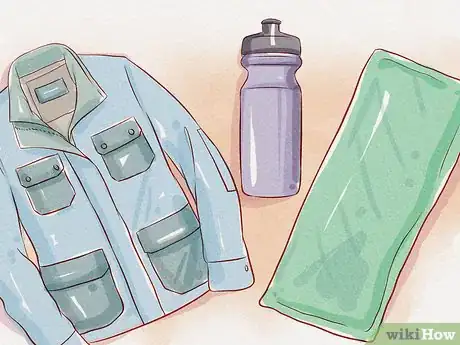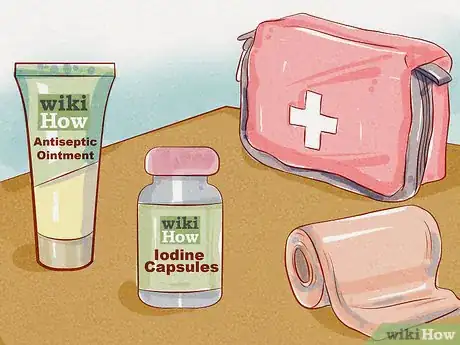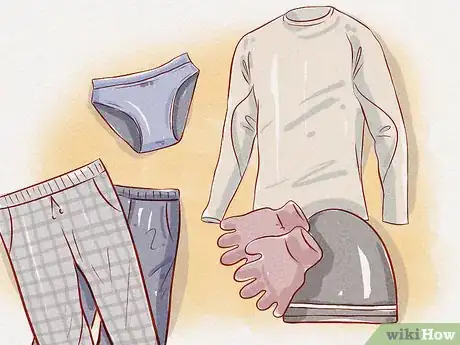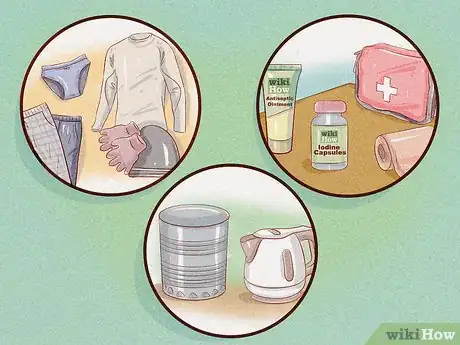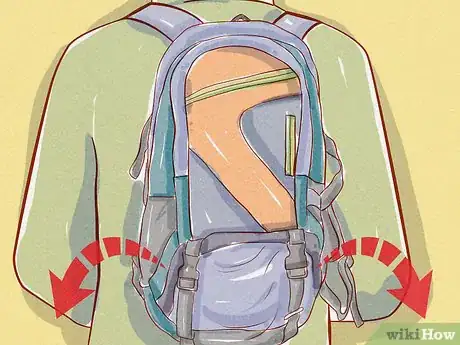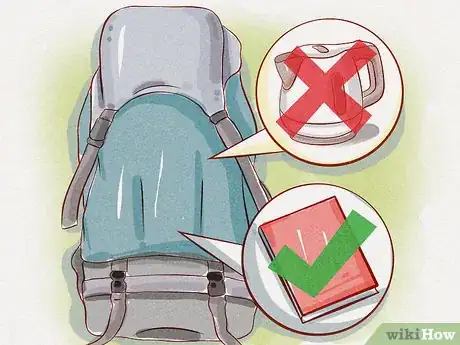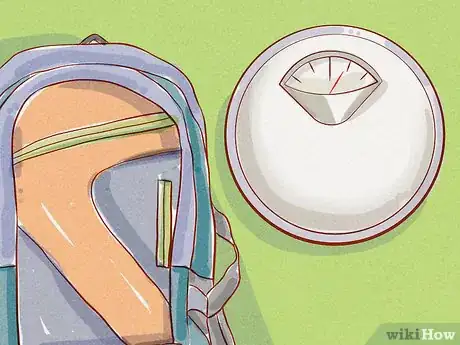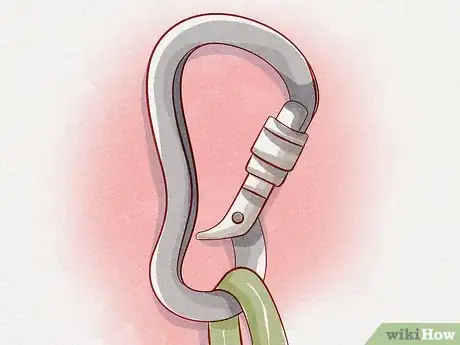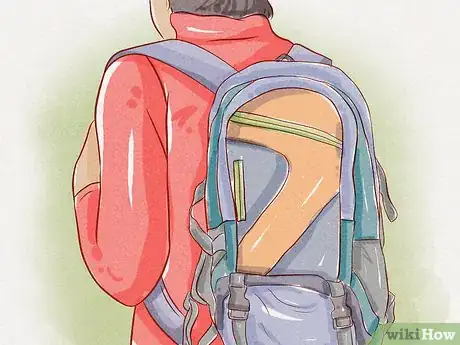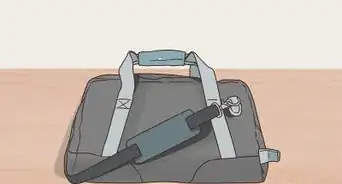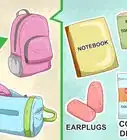This article was co-authored by Josh Goldbach. Josh Goldbach is an Outdoor Education Expert and the Executive Director of Bold Earth Adventures. Bold Earth leads adventure travel camps for teenagers all over the world. With almost 15 years of experience, Josh specializes in outdoor adventure trips for teens both in the United States and internationally. Josh earned his B.A. in Psychology from Eckerd College in St. Petersburg, Florida. He’s also trained as a wilderness first responder, a Leave No Trace master educator, and a Level 5 Swiftwater rescue technician.
There are 7 references cited in this article, which can be found at the bottom of the page.
This article has been viewed 48,634 times.
Rucksacks are usually somewhat larger and sturdier than a school backpack or a daypack, but not quite as serious or large as a backcountry backpack for hiking. A multi-use bag used in all kinds of overnight travel, from bicycling to camping to wandering, a rucksack comes in handy for a variety of situations. Learning to pack a rucksack properly is an art, so it's important to develop a system that's logical for your purposes and allows you to find room for everything you want to take along.
Steps
Bringing the Basics
-
1Get an appropriate rucksack for the job. Whether you'll be hitchhiking across the country or braving the Himalayan winds, a good pack needs the proper volume capacity, weight capacity, and protection against the particular elements you'll be facing on your trip. The weight of the rucksack itself and sometimes the color are also important considerations. Good rucksacks will also be sized to fit your body, with internal frames to offer support.
- The distinction between a rucksack and a backpack is somewhat disputed and the terms are used differently in different places. The process and the principles of packing a rucksack or an internal-frame backpack, though, are basically the same.[1]
- Put something reflective or luminescent on the top of the rucksack so it is easy to find at night. Put your last name on the rucksack, or some other identifying mark that will let you distinguish it from other packs quickly.
-
2Secure shelter, water, and warmth first. If you're going to be traveling in the elements and living out of a bag, you need to make sure you've got the essentials secured, wherever you're going. Being able to stay warm at night, hydrated during the day, and safe from the elements should come before almost any other packing concerns.[2]
- Making room for water or water filtration devices should be your first priority if you're traveling remotely. Almost everything else should come second when compared with providing enough potable water for yourself.
- Are you going someplace that gets cold? Even desert climates can get frigid at night, and you should always travel with at least one layer of warmth, a hat, rain protection, and a lightweight mylar emergency blanket.
- Ideally, you'll have a lightweight tent and a good-quality light sleeping bag that's rated for cold temperatures, if necessary. Even if you're going to be sleeping indoors, a good rucksack kit should include a multipurpose tarp that could be used for ground cover or as a makeshift shelter in a pinch.
Advertisement -
3Bring a basic first aid kit. If you're going to be relying on your own supplies and your own ingenuity to stay healthy and safe, it's important for any rucksack to include at least a basic first aid kit. If the occasion calls for it, more substantial products may also be called for to ensure you'll be prepared for anything. You may want to include some of the following materials:[3]
- Bandages
- Antiseptic ointment or spray
- Isopropyl alcohol
- Pain medication
- Iodine capsules, malaria treatment, or other preventative medication
-
4Prepare for wet conditions. Even if you're going to a sunny warm climate, it's smart to pack assuming it's going to rain every day and that you're going to get wet and cold. You don't want to get caught in a flash flood without rain proofing your essential supplies. Using a rainproof rucksack is best, but it's also acceptable to purchase separate rainproof pouches to keep the most essential items in, like your phone, money, and passport.
- Bring a lightweight raincoat, sturdy shoes, and plenty of socks to change out while you're out in the rain. It's important to stay as dry as possible.
-
5Bring changes of clothes. Prioritize the most versatile, durable, and spartan clothing items and leave the fashionable stuff at home. Again, if you're going to be hoofing it, make sure that you've got useful clothing that you won't mind living in for days at a time, and willing to get dirty. Rainproof gear is desirable, as well as lightweight warm layers that you'll be able to roll up tightly. Depending on your purposes, a good road wardrobe might look something like this:
- Plenty of socks and underwear, at least four back-up pair of each and a patch kit to make little repairs. These are the most essential things to change in and out each day to stay healthy.
- A thermal shirt and underwear that you can use in cold conditions, as well as two or three t-shirts and a lightweight rain jacket.
- At least two pair of long pants and one pair of athletic shorts or swim-trunks. Alternatively, you might be able to get away with a single pair of jeans and a back up for a long trip.
- A stocking cap and wool gloves.
- A heavy coat, if you're going to be traveling in cold conditions.
-
6Bring cooking supplies and extra food. Whether you're going to have food or not, it's a good idea to bring a few essentials that'll allow you to improvise on the fly. Try to make sure you have the necessary ingredients to cook up some food in an emergency, and at least enough stuff to start a fire.
- Try to get a hold of a small kettle and a gas cooker, sometimes called a "hobo stove," as well as a lighter and some waterproof matches. It may be a good idea to have a package of basic candles to keep a flame going for an extended period of time.
- Bring only multipurpose tools. No garlic presses in a rucksack. Don't bring a plate and a bowl, just bring a bowl that you can use for anything that would require a plate. Don't bring a potato peeler, bring a sharp knife that you'll be able to use in a variety of situations.
- Depending on how long you're going to be gone, you might want to bring a bag of granola and simple trail mix, or you may need some MREs, protein bars, and more substantial fare. Try to keep emergency rations on hand, at least enough to sustain you for 48 hours in an emergency.
Pre-Packing
-
1Lay out all the items beforehand. This approach helps to minimize the opportunity to leave out something important, and lets you evaluate whether or not everything you're trying to pack is absolutely essential. As a bonus, having everything in front of you at one time makes it easier to group like items together and pack them in the same compartment of the rucksack, helping to stay organized and efficient.[4]
- Again, consider your purpose. If you're going to the lake house and want to bring your ruck sack, it's probably not essential to bring the camp stove and the fold-up hatchet. Err on the side of keeping it as light as possible.
-
2Prioritize your most used items. Items that you will use throughout the day should be packed in a compartment that can be opened and closed with relatively little effort. Snacks, a swimsuit, your phone, or a change of clothing should be easily accessed without having to remove a number of items from any compartment.[5]
- If you have a single big compartment in your rucksack, the things that you will use as soon as you arrive and continue using frequently should go on top and things you will rarely use should go at the bottom.
- It's usually common, if you're heading out hiking or hitching, to keep your socks on the top of the bag for quick changes and easy access.
-
3Consider using plastic bags for smaller items. Placing small items together in plastic bags with a reclosable top helps to prevent those items from settling during the day and being harder to find when they are needed. Use the bags for snacks, bottled water or other substances that could damage equipment or stain clothing if they were to puncture or otherwise come open.
- It's usually common to keep soap, shampoo, toothpaste, and other toiletries in a plastic bag to avoid spillage and keep the easily accessible.
-
4Find ways to nest items. Before you start jamming everything into your rucksack, check for ways you can start to save space by nesting things into one another. Keep your iPhone in your spare pair of shoes, or wrap up your passport in your jeans. If you're bringing a small foldable pot, keep the camp stove, matches, and other small items in the pot.[6]
- This can be a great way of padding breakable items and hiding valuables. If you've got some extra cash, hide it somewhere a thief would be unlikely to look, deep in the bag. Don't keep it in an external pocket if you can help it.
Making it All Fit
-
1Pack heavy objects in the middle and toward the back. Packing properly will allow the chest and waist straps to bear more of the load, and for the weight to sit on top of your shoulders, rather than pull straps down into them. It will also make it easier to turn and keep your feet as maneuverable as possible. Keep the weight toward the back of the pack, resting against your frame.
- Some rucksacks have openings on the bottom that allow you to unzip and remove items quickly and easily from the base of the sack. These big backcountry-style rucksacks can hold a tremendous amount of weight, meaning that you'll need to play with weight distribution a little more carefully than with a smaller pack that sits higher on your frame.[7]
-
2Balance the weight evenly on both sides of the pack. Set your rucksack upright while you pack the bag and keep weight dispersed over both sides evenly. Follow the same pattern with other items as they are placed in each compartment, taking care to balance the weight from left to right. Doing so helps to reduce fatigue and stress by distributing the load evenly between the shoulders.
-
3Keep the back of the rucksack relatively flat. If you have an internal frame or frameless rucksack, place the flattest items against the panel that lies against your back. Avoid placing soft or bulky items here, since they can deform the shape of the bag, reducing the structural integrity. When you're hoofing around, this can cause uncomfortable bumps or protrusions that will irritate your back.
-
4Use clothes to fill space. Pack your clothes last, unless they make up the most substantial amount of material in your bag. Clothes are the easiest items to use as gap-fillers and jam into the remaining cracks. Plus, you can always get away with having one less pair of gym shorts in an emergency.
- Roll clothing tightly rather than folding it. This will allow the clothes to take up less room while also reducing wrinkles from crushing. Make sure that only enough clothing for the excursion is taken along, as this will help to preserve room for other essentials.
-
5Keep the overall weight of the rucksack under a reasonable limit. This is especially important if hiking or biking for long distances. Opinions vary on how much weight is considered reasonable, although most rucksacks should be less than half of your total body weight at the maximum.
-
6Get some carabiners. As a last resort, it's common to have some important items easily accessible by hanging them off the rucksack from carabiners. This helps to maximize the holding volume of the bag by hooking things onto it, as well as allowing you to quickly grab a hold of a bottle of water, your keys, a knife, or other essentials.
- Most rucksacks are equipped with straps along the bottom that make it possible to secure bedrolls vertically, helping to distribute the weight and save space, as well.
-
7Test it out and check the weight. After everything has been packed, check to ensure that the pack sits comfortably and that you can access items without removing it when necessary. Always wear it for ten minutes minimum and walk around testing the feel of it, mimicking what you will do when wearing your rucksack.
- Pay attention to where you feel the pressure of the straps, and whether or not the bag is throwing off your balance as you move. If so, you may need to reposition some of the items in the bag to distribute the weight more evenly.
- Casual backpack wearers such as students often leave the straps loose and let the rucksack sag low over the rear. Wearing a heavy rucksack loose and low would be miserable on a long trip, so it's important to keep the straps tight and the bag as high on your frame as possible.
References
- ↑ https://buffalojackson.com/blogs/insight/what-is-the-difference-between-a-backpack-and-a-rucksack
- ↑ https://www.outdoorlife.com/blogs/survivalist/practice-4-survival-priorities-shelter-water-fire-and-food
- ↑ https://www.gore-tex.com/blog/hiking-first-aid-kit
- ↑ https://www.theadventurejunkies.com/how-to-pack-a-backpack-for-hiking/
- ↑ http://www.thetravellerslounge.co.uk/packingtips.htm#.VCxfpEvB7Kw
- ↑ https://americanhiking.org/resources/how-to-pack-a-backpack/
- ↑ http://pone.com/T96/backpack.htm
About This Article
To pack a rucksack, pack your heaviest items in the middle and toward the back, which will help distribute the weight more evenly. Also, make sure you balance the weight evenly on both sides of your rucksack so one side of your body doesn't get more tired than the other. You should also try to pack flat items against the panel that rests against your back since bulky objects can cause pain and irritation. To learn how to pack all of the necessities in your rucksack, keep reading!

